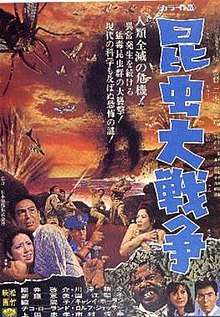Genocide (1968 film)
Genocide (昆虫大戦争, Konchu daisenso, lit.Great Insect War) is a 1968 Japanese science fiction horror film directed by Kazui Nihonmatsu.[2]
| Genocide | |
|---|---|
 Theatrical release poster | |
| Directed by | Kazui Nihonmatsu |
| Produced by | Tsuneo Kosumi[1] |
| Screenplay by | Susumu Takaku |
| Story by | Kingen Amada[1] |
| Music by | Shunsuke Kikuchi[1] |
| Cinematography | Shizuo Hirase[1] |
| Edited by | Akimitsu Terada[1] |
Production company | |
Release date |
|
Running time | 84 minutes[1] |
| Country | Japan |
Cast
- Keisuke Sonoi as Yoshito Nagumo
- Yûsuke Kawazu as Joji Akiyama
- Emi Shindo as Yukari Akiyama
- Reiko Hitomi as Junko Komura
- Eriko Sono as Nagumo’s assistant
- Kathy Horan as Annabelle
- Chico Roland as Charlie
- Ralph Jesser as Lieutenant Colonel Gordon
Production
Genocide was co-written by Susumu Takaku, an anime and live-action screenwriter.[4] The films staff includes Shizuo Hirase as the cinematographer who also worked on the Shochiku films The X from Outer Space and Goke, Body Snatcher from Hell.[4]
Release
Genocide was released in Japan on 9 November 1968.[1] It was released as a double feature with The Living Skeleton.[5][6] The film was released in the United States by Shochiku Films of America in 1969.[1] The film was promoted under the title War of the Insects on this release.[1]
The Criterion Collection released Genocide on DVD in a compilation set titled When Horror Came to Shochiku through their Eclipse label.[7] The box set was released on November 20, 2012.[8]
Reception
Slant Magazine described the film as "appropriately harrowing" and one where women "come under the most direct indictment". The review opined that Nihonmatsu "handles with considerably more skill than his prior Shochiku effort" and that "Genre films don't often cover as much ground stylistically or thematically as Genocide, let alone get more bleak (the film ultimately hinges on the potential detonation of a hydrogen bomb and the single mother that may have to single-handedly repopulate a country), but as the last horror film Shochiku would produce, it's suitably ambitious and apocalyptic in its finality."[9] Sight & Sound described Genocide as an "accident of a film" that "plays mostly as a national symptom, in a legacy of scenarios devised both to make sense of, and to reduce to pulp the memories of nuclear heat-death".[10]
See also
References
Footnotes
- Galbraith IV 1996, p. 180.
- "War of the Insects". AllMovie. Retrieved 28 August 2016.
- "Genocide (1968)". Criterion Collection. Retrieved 28 August 2016.
- Stephens, Chuck. "Eclipse Series 37: When Horror Came to Shochiku". Criterion Collection. Retrieved 28 August 2016.
- Galbraith IV 1994, p. 320.
- Galbraith IV 1994, p. 321.
- "Eclipse Series 37: When Horror Came to Shochiku". Criterion Collection. Retrieved August 23, 2016.
- "The X From Outer Space (1967)". AllMovie. Retrieved August 23, 2016.
- Cronk, Jordan (2 January 2013). "Eclipse Series 37: When Horror Came to Shochiku". Slant Magazine. Retrieved 28 August 2016.
- Atkinson, Michael (January 2013). "Shochiku's Schlock Wave". Sight & Sound. Vol. 23 no. 1. British Film Institute. p. 118.
Sources
- Galbraith IV, Stuart (1994). Japanese Science Fiction, Fantasy and Horror Films. McFarland. ISBN 0-89950-853-7.CS1 maint: ref=harv (link)
- Galbraith IV, Stuart (1996). The Japanese Filmography: 1900 through 1994. McFarland. ISBN 0-7864-0032-3.CS1 maint: ref=harv (link)